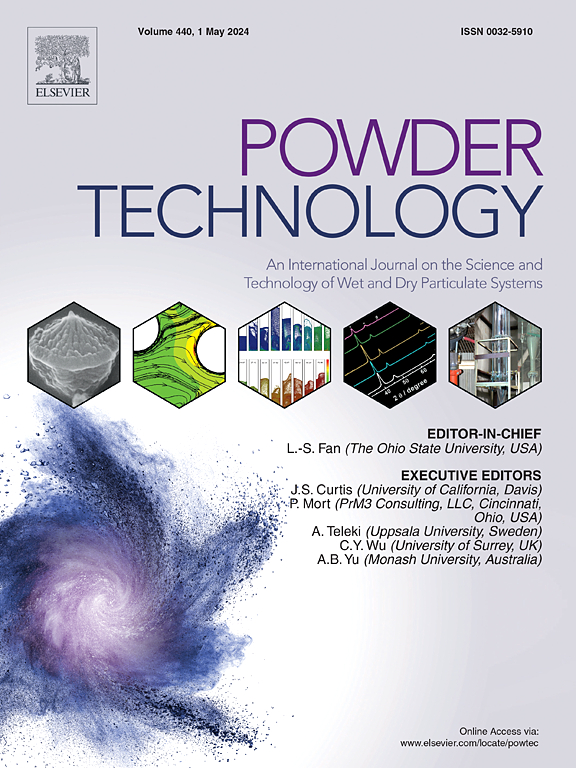Pore network modeling of iron ore agglomerates: Development of a methodology based on X-ray microtomography
IF 4.5
2区 工程技术
Q2 ENGINEERING, CHEMICAL
引用次数: 0
Abstract
One of the most relevant characteristics of iron ore agglomerates is their porosity, which strongly impacts their performance in the steelmaking processes. This performance depends on a porous network allowing the gas to flow through its interior without compromising its integrity. However, there is a noticeable lack of research on the relationship between flow properties, absolute permeability, and the porous structure of agglomerates, especially for cold agglomerated iron ore. This work presents a methodology for characterizing iron ore agglomerates by identifying their pore network structure using X-ray microtomography (MicroCT) and Pore Network Modeling (PNM). The methodology was applied to iron ore pellets and cold agglomerates. Thus, the influence of the microstructure of these agglomerates on the variation of their porosity and permeability was evaluated. MicroCT provided a 3D visualization of the agglomerates' microstructure, allowing the pore space's discrimination. PNM was used to simulate the absolute permeability of the samples, correlating it with porosity, pore connectivity, and pore diameters and connections. The images were acquired with a 2 μm voxel size, and the obtained porosity was around 20 %. In addition, consistent results of the agglomerates' absolute permeability were found, ranging from 0.03 to 2.4 mD. From the developed methodology, it is possible to explore the relationship between porosity, permeability, and reducibility of agglomerates. Future research can use this approach to optimize process parameters and improve the efficiency of steel production by deepening the understanding of the influence of microstructure on the physical properties and performance of the reduction process.

铁矿团块孔隙网络建模:基于x射线微层析成像方法的发展
铁矿石结块最重要的特征之一是它们的孔隙率,这对它们在炼钢过程中的性能有很大的影响。这种性能取决于多孔网络,允许气体流过其内部而不损害其完整性。然而,对于流动特性、绝对渗透率和团聚体孔隙结构之间的关系的研究明显缺乏,特别是对于冷团聚的铁矿石。本工作提出了一种通过使用x射线微断层扫描(MicroCT)和孔隙网络建模(PNM)识别其孔隙网络结构来表征铁矿石团聚体的方法。将该方法应用于铁矿球团和冷结块。因此,评价了这些团聚体的微观结构对其孔隙度和渗透率变化的影响。MicroCT提供了团块微观结构的三维可视化,从而可以识别孔隙空间。采用PNM模拟样品的绝对渗透率,将其与孔隙度、孔隙连通性、孔径和连通性相关联。图像的体素尺寸为2 μm,孔隙率约为20%。此外,发现团块的绝对渗透率在0.03 ~ 2.4 mD之间,结果一致。通过开发的方法,可以探索团块的孔隙度、渗透率和还原性之间的关系。未来的研究可以通过加深对微观组织对还原过程物理性能和性能影响的理解,利用这种方法来优化工艺参数,提高钢的生产效率。
本文章由计算机程序翻译,如有差异,请以英文原文为准。
求助全文
约1分钟内获得全文
求助全文
来源期刊

Powder Technology
工程技术-工程:化工
CiteScore
9.90
自引率
15.40%
发文量
1047
审稿时长
46 days
期刊介绍:
Powder Technology is an International Journal on the Science and Technology of Wet and Dry Particulate Systems. Powder Technology publishes papers on all aspects of the formation of particles and their characterisation and on the study of systems containing particulate solids. No limitation is imposed on the size of the particles, which may range from nanometre scale, as in pigments or aerosols, to that of mined or quarried materials. The following list of topics is not intended to be comprehensive, but rather to indicate typical subjects which fall within the scope of the journal's interests:
Formation and synthesis of particles by precipitation and other methods.
Modification of particles by agglomeration, coating, comminution and attrition.
Characterisation of the size, shape, surface area, pore structure and strength of particles and agglomerates (including the origins and effects of inter particle forces).
Packing, failure, flow and permeability of assemblies of particles.
Particle-particle interactions and suspension rheology.
Handling and processing operations such as slurry flow, fluidization, pneumatic conveying.
Interactions between particles and their environment, including delivery of particulate products to the body.
Applications of particle technology in production of pharmaceuticals, chemicals, foods, pigments, structural, and functional materials and in environmental and energy related matters.
For materials-oriented contributions we are looking for articles revealing the effect of particle/powder characteristics (size, morphology and composition, in that order) on material performance or functionality and, ideally, comparison to any industrial standard.
 求助内容:
求助内容: 应助结果提醒方式:
应助结果提醒方式:


